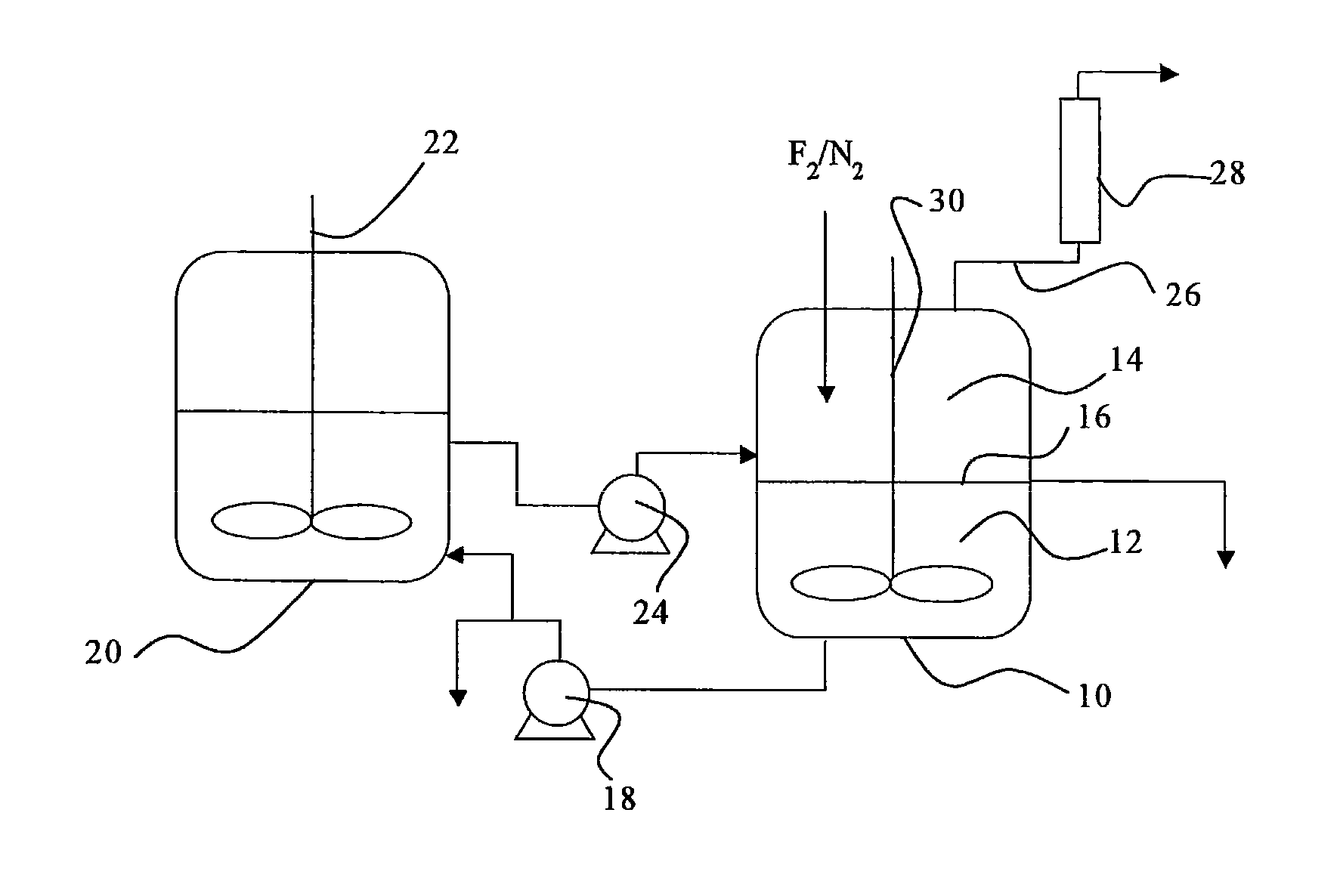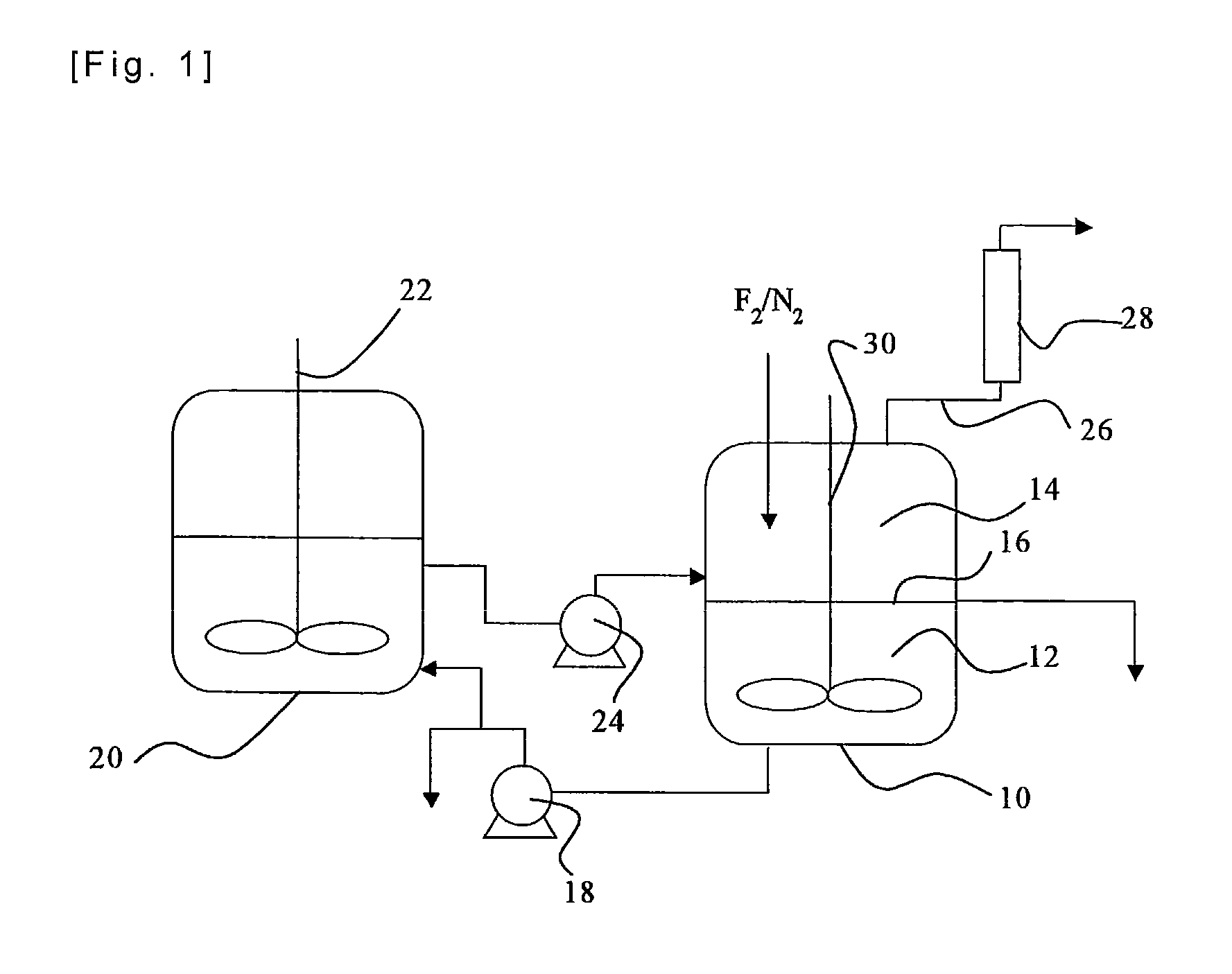Process for production of iodine pentafluoride
a technology of iodine pentafluoride and process, which is applied in the direction of inorganic chemistry, inter-halogen compound, halide preparation methods, etc., can solve the problems of difficult operation of the reactor at an elevated temperature for the purpose of avoiding such iodine deposition, and the industrial value of processes is not so useful, so as to reduce the risk of iodine deposition and solidification in the line
- Summary
- Abstract
- Description
- Claims
- Application Information
AI Technical Summary
Benefits of technology
Problems solved by technology
Method used
Image
Examples
example 1
[0058]Iodine (40 g) and iodine pentafluoride (223 g) were charged in a reactor made of a fluorine resin (PFA) having an inner volume of 150 ml, and stirred so as to prepare a liquid phase in the state of a slurry. Fluorine and nitrogen were supplied to the gas phase of the reactor at flow rates of 50 Ncc / min. and 50 Ncc / min., respectively. The reaction of iodine and fluorine was started while an inside temperature of the reactor was kept at a temperature in the range between 30 and 50° C. by cooling the reactor in an ice bath. The reaction was continued for six hours, and no back stream of iodine into the nitrogen line or the fluorine line was observed, so that the reaction proceeded smoothly. Noncondensed gas discharged from the reactor was analyzed by a ultraviolet-visible spectrophotometer, and it was found that a conversion of fluorine was 98 mol %. The liquid phase in the reactor was composed substantially of iodine pentafluoride, and iodine disappeared.
example 2
[0060]Iodine (75 g) and iodine pentafluoride (300 g) were charged and stirred in an autoclave made of a metal (SUS 316) having an inner volume of 200 ml, so that a liquid phase in the state of a slurry was prepared. A mixture gas of fluorine (90 Ncc / min.) and nitrogen (10 Ncc / min.) was supplied to the gas phase of the autoclave, and the reaction of iodine and fluorine was started with stirring at a rotation speed of 500 r.p.m. while an inside temperature of the autoclave was kept at a temperature in the range between 30 and 50° C. by cooling the autoclave in an ice bath. The reaction was continued for seven hours, and no back stream of iodine into the nitrogen / fluorine line was observed, so that the reaction proceeded smoothly. The liquid phase left in the reactor was recovered, all of iodine in the reactor was consumed, and the iodine was absent, and the liquid phase was a transparent and colorless liquid. The liquid was analyzed by 19F-NMR, and it was found that it contained 100 m...
example 3
[0061]A liquid phase of a slurry was prepared in an autoclave made of a metal (SUS 316) having an inner volume of 200 ml as in Example 2. A mixture gas of fluorine (180 Ncc / min.) and nitrogen (20 Ncc / min.) was supplied to the gas phase of the autoclave, and the reaction of iodine and fluorine was started with stirring at a rotation speed of 500 r.p.m. while an inside temperature of the autoclave was kept at a temperature in the range between 30 and 50° C. by cooling the autoclave in an ice bath. The reaction was continued for three hours, and no back stream of iodine into the nitrogen / fluorine line was observed, so that the reaction proceeded smoothly. Noncondensed gas discharged from the autoclave was analyzed by a ultraviolet-visible spectrophotometer, and it was found that a conversion of fluorine was always not smaller than 98%. After the reaction, the charged iodine was not completely consumed, and an amount of iodine was left in the autoclave, and there was no deposition of so...
PUM
| Property | Measurement | Unit |
|---|---|---|
| temperature | aaaaa | aaaaa |
| temperature | aaaaa | aaaaa |
| temperature | aaaaa | aaaaa |
Abstract
Description
Claims
Application Information
 Login to View More
Login to View More - R&D
- Intellectual Property
- Life Sciences
- Materials
- Tech Scout
- Unparalleled Data Quality
- Higher Quality Content
- 60% Fewer Hallucinations
Browse by: Latest US Patents, China's latest patents, Technical Efficacy Thesaurus, Application Domain, Technology Topic, Popular Technical Reports.
© 2025 PatSnap. All rights reserved.Legal|Privacy policy|Modern Slavery Act Transparency Statement|Sitemap|About US| Contact US: help@patsnap.com


